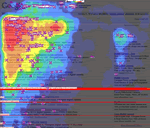How To Get Visitor Traffic To Your New Website
October 15th, 2007 So you’ve just gotten a new website finished – maybe Aldebaran Web Design even developed it for you. If so, you’re in luck because it was designed to W3C industry standards and adheres to Google’s Quality Guidelines and is ready for the world!
So you’ve just gotten a new website finished – maybe Aldebaran Web Design even developed it for you. If so, you’re in luck because it was designed to W3C industry standards and adheres to Google’s Quality Guidelines and is ready for the world!
So what should a new website owner do next?
Once your website is designed, your next step is to think about how you’re going to get real people, out there in internet-land, to visit your website. Just because it was built, there’s no guarantee they will come. Think of it…as of February 2007, there were over 108 million websites. How do people find your website among the millions?
Here are a few of the major ways people find websites:
1. By putting keywords into a Search Engine and clicking on the organic or natural (free) results.
2. By putting keywords into a Search Engine and clicking on the paid or sponsored links (pay-per-click advertising like Google AdWords. I offer Google AdWords Campaign Management for my clients…click here to read more .)
3. By visiting a directory (like YellowBook.com, local.yahoo.com, etc). (Read my article on how to get into the directories for free)
4. By following a link from someone else’s web page (like from my portfolio)
5. By clicking on an online advertisement, such as a banner ad.
6. By clicking on a pay-per-click link that shows up on a website portal that you happen to be on (like MySpace or Yahoo Mail).
7. By clicking on a link embedded in an email sent by you (via a newsletter perhaps)
8. By finding you in the media (TV, Radio, Newspaper, Magazines, etc)
Sound complicated? That’s because it is. Getting folks to visit websites is a huge industry. But it is important that all new website owners understand how each of these channels works, and which might best suit their small business.
Since I get most of my own website traffic from search engines, I’ll talk about about getting traffic via organic searches and pay-per-click advertising campaigns first.
Let’s take a quick tour of the Google Search Engine page:

You can clearly see the two regions, the natural organic results, and the sponsored links (pay-per-click).
Natural Organic Results. When you click on the organic results, no one gets charged anything. The super-secret ultra-smart Google algorithm decides that these 10 pages are the best match for what you’re looking for. The one that Google thinks is the most relevant will be first. The algorithm decides this, you can’t pay Google to put you there.
Sponsored Links. You can pay Google or the other search engines to link to you in the “sponsored results” section. If a user clicks on a sponsored result, the website owner who placed that ad will get charged for one “click.” Maybe they’re charged $1, maybe $10, it all depends on the market. Whoever bids the most per click winds up at the top of the sponsored list (Google AdWords has a more complicated algorithm that determines who’s on top). You can set a daily limit on how much you want to spend.
Which is better, being #1 in the Organic Results or being #1 in Sponsored Links?
There was an amazing study done in 2005 by two search engine marketing firms and an eye-tracking firm that tried to answer this very question. They tracked where people’s eyes went when they looked at search results in Google.
Here’s what they discovered…
For visual folks, here’s a color coded map of where subjects looked:

And for numbers-oriented folks, here’s a table with the same data:

They discovered that the top sponsored links were viewed by 50% of the people, while the top organic results were viewed by 100% of the people. This means that a #6 or #7 organic result was equivalent to a #1 paid sponsored link, and vice versa. Think about this and remember it. It’s incredible information that isn’t widely known to small business owners who are looking to ways to get more traffic to their websites. (Go here to read the original study findings, dubbed “Google’s Golden Triangle”.)
So why would anyone pay for a click when they can get them for free? … Great question!
 It’s not free at first. Getting good organic search engine rankings is not free – it’s more of an investment that pays dividends later. It takes many many many hours of search engine optimization effort, time and lots of patience. And it often takes maintenance, to keep your website high in the rankings once you’ve gotten there, because other website owners may be doing the same thing, if they’re smart.
It’s not free at first. Getting good organic search engine rankings is not free – it’s more of an investment that pays dividends later. It takes many many many hours of search engine optimization effort, time and lots of patience. And it often takes maintenance, to keep your website high in the rankings once you’ve gotten there, because other website owners may be doing the same thing, if they’re smart.
 It’s not fast. Good organic search engine rankings don’t happen overnight. They’re the result of working hard to get other quality websites to link to yours (creating inlinks), constantly working on the structure and content of every page, using all kinds of online analysis tools to figure out how the websites that are ranked ahead of you got there, and then waiting for the search engines to visit again….observe the new ranking results…and do it all over again and again. If you start a Google AdWords Campaign today, you’ll start getting traffic immediately.
It’s not fast. Good organic search engine rankings don’t happen overnight. They’re the result of working hard to get other quality websites to link to yours (creating inlinks), constantly working on the structure and content of every page, using all kinds of online analysis tools to figure out how the websites that are ranked ahead of you got there, and then waiting for the search engines to visit again….observe the new ranking results…and do it all over again and again. If you start a Google AdWords Campaign today, you’ll start getting traffic immediately.
So what should a new website owner do to get traffic?
 1. Work on getting high quality, relevant inlinks to your website. Get links to your website from the websites of friends, relatives, or business associates. Get listed in quality directories. Work on this constantly, a little bit at a time. There are many good directories that will list your website for free, others you may have to pay a fee for. If you have a physical address, make sure you get into search engine local directories like Google Local, Yahoo Local, MSN Local. Get into DMOZ. If you’re in Seattle, look for “Seattle directories”. Get as many as you can…dozens, hundreds!
1. Work on getting high quality, relevant inlinks to your website. Get links to your website from the websites of friends, relatives, or business associates. Get listed in quality directories. Work on this constantly, a little bit at a time. There are many good directories that will list your website for free, others you may have to pay a fee for. If you have a physical address, make sure you get into search engine local directories like Google Local, Yahoo Local, MSN Local. Get into DMOZ. If you’re in Seattle, look for “Seattle directories”. Get as many as you can…dozens, hundreds!
Avoid “link farms”, those places that promise you a bizillion inlinks overnight. And try to avoid reciprocal links, where you put a link to your website in exchange for another website linking to yours. If it’s a business you are familiar with, that’s fine, but if it’s some strange website that has nothing to do with your business, be wary. You can get penalized for linking to what Google considers “bad neighborhoods”.
Go after directories and websites that have good pagerank. The higher the pagerank, the more value the search engines will place on the link to your page. Go here to check the pagerank of any website. All new websites start with a pagerank of 0 and slowly work their way up to 2 or 3 as they get good quality inlinks and age.
Monitor your inlinks. Here are a few tools you can use: BackLinkChecker, SmartPageRank, Yahoo Site Explorer. Notice several things: the “Anchor Text” (should match your keywords), PR (page rank), OBL (how many other outbound links are on the page in addition to yours, more is worse for you), Flag – if anyone has linked to you using “NoFollow” – this is an unethical site. NoFollow means they’ve added code to tell the search engines NOT to follow the link – therefore, it’s not helping you at all. And check the “www” and without “www” version of your site, you need to be consistent to concentrate the links, don’t mix them, pick one and stick to it.
2. Look into pay-per-click advertising. Be sure to read my article on click fraud. Google provides an excellent resource for learning about pay-per-click via Google Ad Words.? Because new websites are often penalized by Google and Yahoo, pay-per-click may be the only way of generating adequate traffic for new websites. My own website was in the “Google Sandbox” for nearly 8 months. That’s 8 months of visitors that I could count on one hand each day. I was fine waiting, but many small business owners can’t afford the delay.
3. Look into hiring someone to do Search Engine Optimization (SEO). Remember SEO will not bring you instant traffic, but may take many months or longer to see a return on this investment. However once you’ve achieve good organic rankings, you get traffic without paying anyone for clicks. I used SEO on my own website to get great rankings for “website design seattle”. (Put these words into Google and see where my website is at – don’t hire a website designer for SEO until you check their own website’s rankings!). Go here to read about my SEO services.
 4. Track your website traffic and LOOK at the data. You should be studying your website traffic in order to see where people are coming from, what keywords they’re using, and what they do once they enter your home page. I recommend all my clients let me install a traffic tracking tool like Web-Stat on their websites, especially if they’re undertaking an organic search engine optimization campaign or a pay-per-click advertising campaign.
4. Track your website traffic and LOOK at the data. You should be studying your website traffic in order to see where people are coming from, what keywords they’re using, and what they do once they enter your home page. I recommend all my clients let me install a traffic tracking tool like Web-Stat on their websites, especially if they’re undertaking an organic search engine optimization campaign or a pay-per-click advertising campaign.
Whew! Getting visitors to your new website is complicated and you have many different options to choose from…feel free to contact me about anything I’ve written about here – or even if I’ve left something out that you want me to mention or even research.
Jill--------------
J. Olkoski
Aldebaran Web Design, Seattle
Jill Olkoski has a BS in Engineering, a BS in Computer Science and an MA in Clinical Psychology. She delights in using her advanced technical and psychological skills to help small business owners develop cost-effective and successful websites.
